
New Nissan Juke Hybrid 2022 review

Introduction
Nissan is continuing the electrification of its range by adding an emission-free motor to the Juke.
It is part of a plan to offer at least a hybrid version of all its cars by 2023 and follows on from its larger sibling, the Qashqai, of which a mild hybrid version was launched last year.
If you’re familiar with the Juke, you’ll know its looks are full of personality, if a bit on the ugly side. However, Nissan has tried to rid it of the frog-like front end it used to have.
Select's rating score* - 3.7 / 5
At A Glance
While it still retains the large circular lights at either side, the rest of the front has been heavily revised, with thin lights merging into a larger V-shaped silver bar, which sits beneath the main grille.
There is an extra trim piece on the front and a grille shutter. This shutter opens and closes by itself due to the hybrid version not needing as much cooling.
It still doesn't wear its uniform like some of its rivals. However, it's anything but bland.
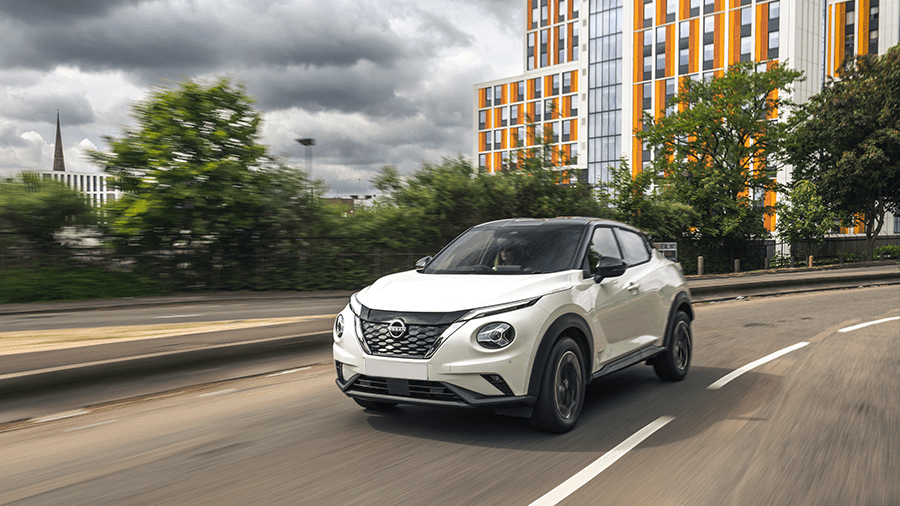
From the side, there's a sizeable sharp indentation in the lower part of the doors to accentuate some sportiness. Meanwhile, the windows taper in towards the back. There is a roof spoiler overhanging the back window, while the rear sticks out noticeably when viewed side-on.
Nissan has actually revised the roof spoiler, reprofiling it for improved aerodynamic efficiency, while there are also aerodynamic bladed alloy wheels available.
The back is full of personality, too, with the rear lights sticking out slightly from the bodywork and a flattened hexagon shape surrounding the number plate. There is a blackened bumper at the bottom, too, which emphasises its SUV credentials.
The bodywork beneath the bumper has also had aerodynamic tweaks to help improve airflow and reduce drag.

There is also the addition of new badges, including Nissan’s revised minimalistic logo, plus you get hybrid badges in various places.
Overall, it's a busy, stylish design that's an improvement on the old looks, especially at the front, although we're divided as to whether it's good-looking.
If you're familiar with Nissans, the same could be said for most of its cars.

Key Features
There are five trims in the Juke’s range, but the two entry-level trims are only available on the non-hybrid version.
If you do opt for the non-hybrid, entry-level Visia gets you 16-inch steel wheels, black cloth seats, pearl black door mirrors, LED headlights and day running lights, a DAB radio, Bluetooth, USB sockets, a 4.2-inch digital display, cruise control and speed limiter. Acenta trim gets you 17-inch alloys, an eight-inch NissanConnect touchscreen with Apple CarPlay and Android Auto and a rear-view camera.
The hybrid version begins with N-Connecta trim, which gets all the above on 17-inch rims, a TomTom SatNav, and a seven-inch digital instrument display. You also get keyless entry which locks and unlocks the car depending on your distance from it, an electric handbrake and auto-hold function, automatic climate control and a leather steering wheel and gear lever knob.

Tekna trim upgrades the alloys to 19-inches and adds an advanced safety shield pack, a Bose audio system, a heat pack including heated front seats and a heated windscreen, and interior ambient lighting.
Top-of-the-range Tekna+ gets 19-inch Aero alloys from the Nissan Ariya, as well as two-tone metallic paint and personalisation packs for the interior and exterior, which add coloured inserts on the front and rear bumpers and the side skirts, and a satin silver front bumper.
At launch, there’s a limited run of a Premiere Edition trim, of which only 750 will be made. It is N-Connecta spec but features 19-inch gloss black wheels, black-tinted headlights, Syntec leather, and other unique styling touches.
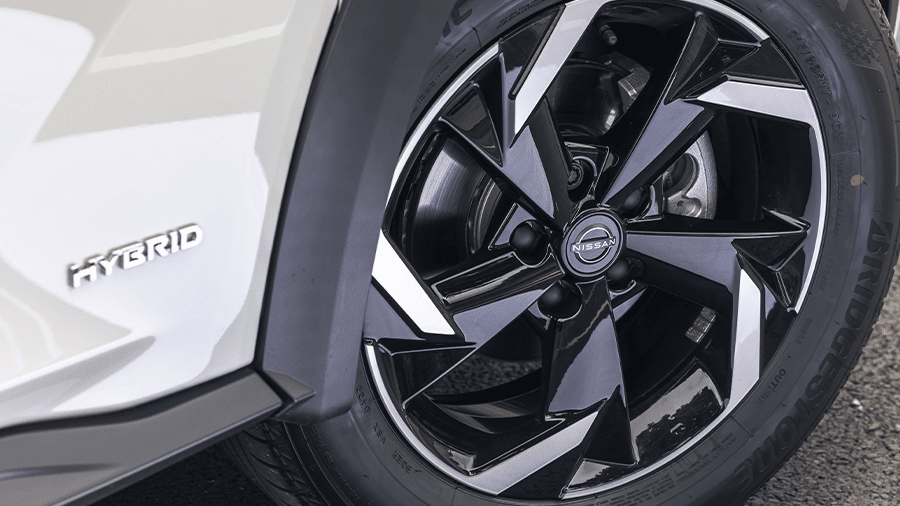
The powertrain comprises a 94PS 1.6-litre petrol engine, which combines with a 49PS electric motor for a total of 143PS, a significant increase on what you currently get in the petrol-only Juke, which has a 1.0-litre three-cylinder engine producing around 114PS.
It is front-wheel-drive only, and no four-wheel-drive version is offered, but for crossover SUVs, that’s not unusual.
The all-electric range of the Juke Hybrid is just two miles, but that might be enough to do the school run.
The battery is only a tiny 1.25kWh, but the regenerative braking system, which works alongside the one-pedal driving mode called e-Pedal Step, will feed some power back into the battery under deceleration, which should help.
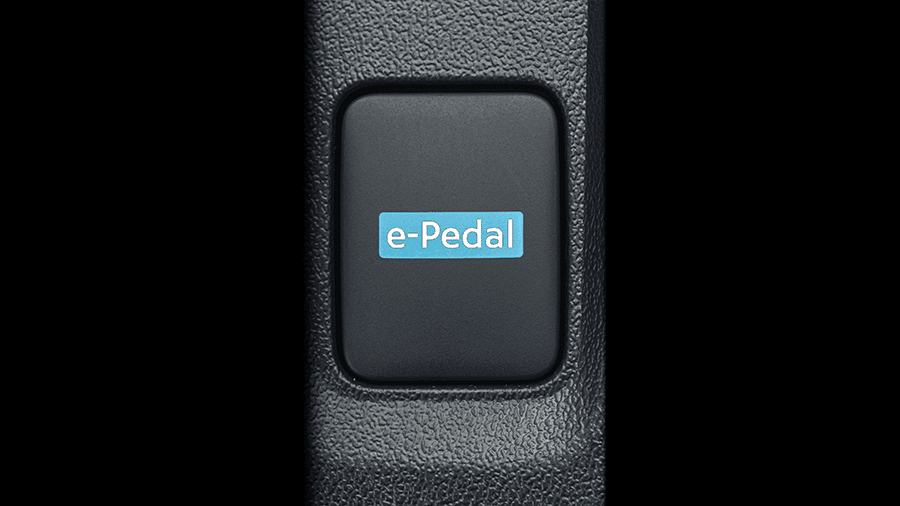
Performance & Drive
Nissan claims that the new hybrid powertrain feels like an all-electric car – and we can see why.
Each time you start it up, it always starts on electric power only, with the first two of its six gears only affecting the electric motor. After that, third gear and 35mph force the engine into action.
You can prevent this by putting it into EV mode, and the power usage and remaining charge are displayed on the infotainment touchscreen.
Driving around town, the Juke feels up to the job. While acceleration is limited on all-electric power, it has an adequate amount to make good progress.

With the engine, it’s noticeably sprightlier than the all-petrol Juke, thanks to the extra power. But, like its all-fossil-fuelled sibling, it still feels a little strained when you try to push it up to motorway speeds.
Overtaking isn't its strong suit, though pop it into Sports mode, and you do notice more throttle response when pressing your right foot. But 'sport' might be an exaggeration as it isn't incredibly athletic. It also firms up the steering, although this feels a little artificial and doesn't add much to the driving experience.
It has plenty of grip in the corners, but thanks to the steering, it isn't as responsive. And as a result, it isn't geared up for providing thrills in the bends on twisty backroads.
While the new aerodynamically efficient bladed alloy wheels may help reduce drag and maximise your all-electric range, they're bigger. Therefore, the ride comes with the penalty of being firmer.
This is a trait of the all-petrol Juke, and the extra weight of the electric motor and the battery (even though it's small) all adds up. Potholes and creases in the road aren’t amazingly smooth as a result.
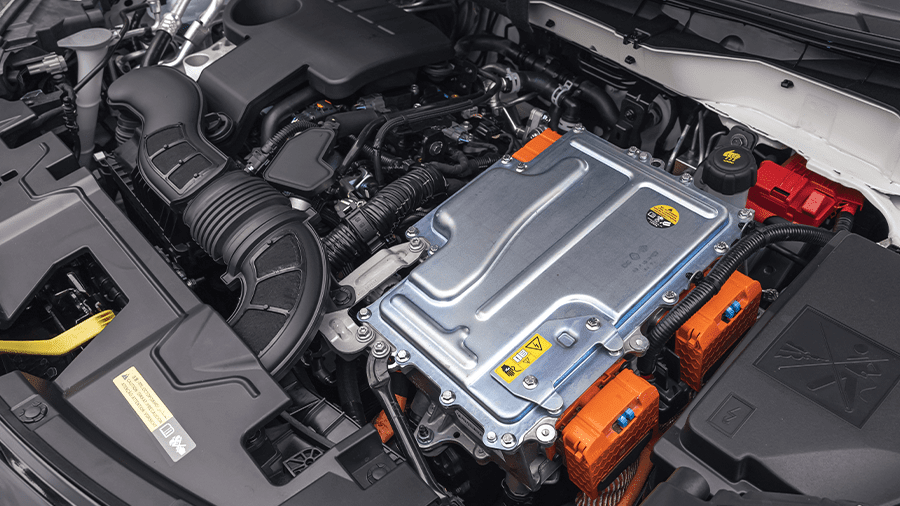
It is a comfortable cruiser on motorways, where it feels more at home. But putting your foot down won’t yield the results you might hope for.
This might all sound rather negative. But while the Juke doesn't excel in any particular area, it's still a good all-rounder, and every aspect of the driving experience is improved over its predecessor.
In truth, because the car's handling isn't incredibly athletic, the extra weight from the electric motor and batteries isn’t especially noticeable. As a result, it doesn't seem to affect the driving experience too much.
In addition, the automatic gearbox in the hybrid changes smoothly. However, the lack of a manual means there's limited involvement or influence upon its acceleration from a standing start, which makes the vehicle's lack of outright grunt a bit more noticeable.
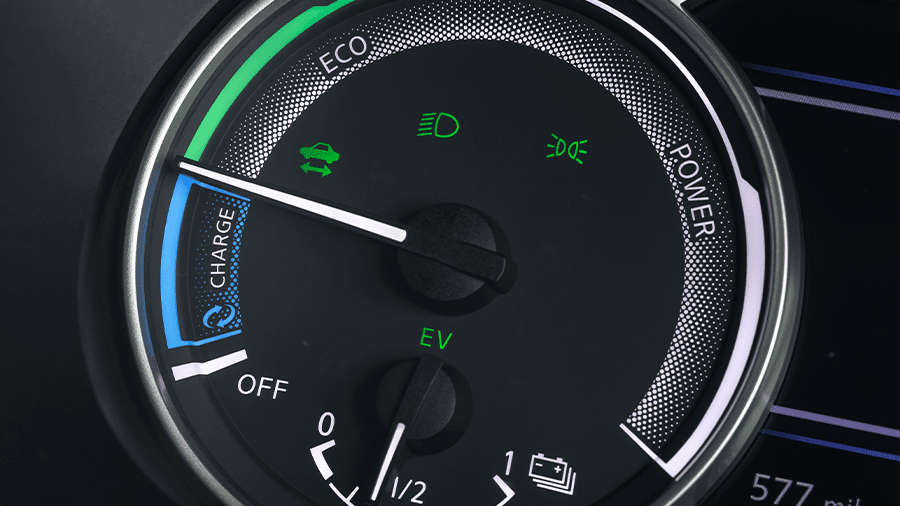
Running Costs & Emissions
The Juke Hybrid averages 56.5mpg, which is pretty good, and it’ll do 571 miles on a full tank of petrol. CO2 emissions have been measured at 115g/km. If you want to know more about hybrid cars, take a look at our guide to hybrid electric vehicles.
While these figures aren’t competitive compared with what you’d see in plug-in hybrids with bigger batteries, they are creditable numbers compared with most petrol cars.
Of course, suppose you're environmentally conscious and use all-electric mode around town centres. In that case, you have the satisfaction of knowing that, for a tiny portion of your journey at least, you're driving an emissions-free vehicle.
The Juke is generally considered a dependable car. But, unlike some of its Far Eastern counterparts, Nissan, for your information, only offers a three-year warranty. It is an unlimited mileage guarantee, however.
While it may be in a lower band for Benefit In Kind (BIK), there are more attractive bottom-band options for company car drivers, thanks to plug-in hybrids and all-electric cars.

Interior & Technology
Inside, the Juke is impressive and very pleasant. It isn’t the height of luxury by any means, but it certainly looks stylish, with a flat-bottomed steering wheel, three circular air vents in the middle and the infotainment screen plonked on top.
The centre console is rounded and has a premium feel to it. And overall, it's a significant improvement on what came before, even though some cheaper scratchy plastics are on display.
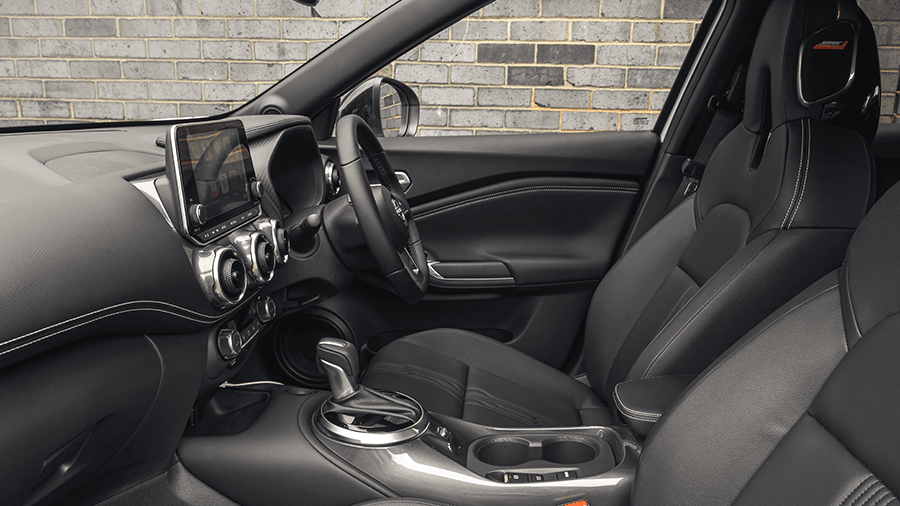
Indeed, the addition of bits of silver trim and shiny black help to give a cooler feel and, like the exterior, the interior is anything but mundane.
The Bose audio system in the Tekna trim sounds nice, and we can see how welcoming the heated seats will be in winter.
The infotainment system has been overhauled and now features menu shortcuts to make finding your way around easier. Although it's a step forward on Nissan's old system, rivals still have the upper hand.

You get a reading of how much energy you're using on the new digital display, while the dials have been updated to show the remaining battery charge. It is disappointing that the dials are not entirely digitised, however.
Being an SUV crossover, you get a higher driving position than you would in a standard hatchback. But the bonnet does sit relatively high up, too, so it limits your view of the road ahead. However, you can adjust the seat as high as you like.
The pillars at the rear are also quite large thanks to the angle of the back window. So, it’s not the best car for visibility, although all hybrids get a camera to help with this.

Practicality & Boot Space
The front is spacious, and the seats are very comfortable, while the Nissan Juke is wide enough to prevent you from rubbing shoulders with the person sitting next to you.
Thankfully, the Juke has a longer wheelbase these days, so there's more space in the back for fully-grown adults. If you're tall, headroom might still be a problem, but it's nowhere near as bad as it used to be. That said, you'll still struggle to fit more than two adults in the back.
In terms of storage space, the front door bins aren't huge; the ones in the back are even smaller, and the glove compartment is also small-ish. The front armrest is quite deep, but it's also narrower than you'd find in some rivals' cars. There is only one cupholder in the entire vehicle, too.
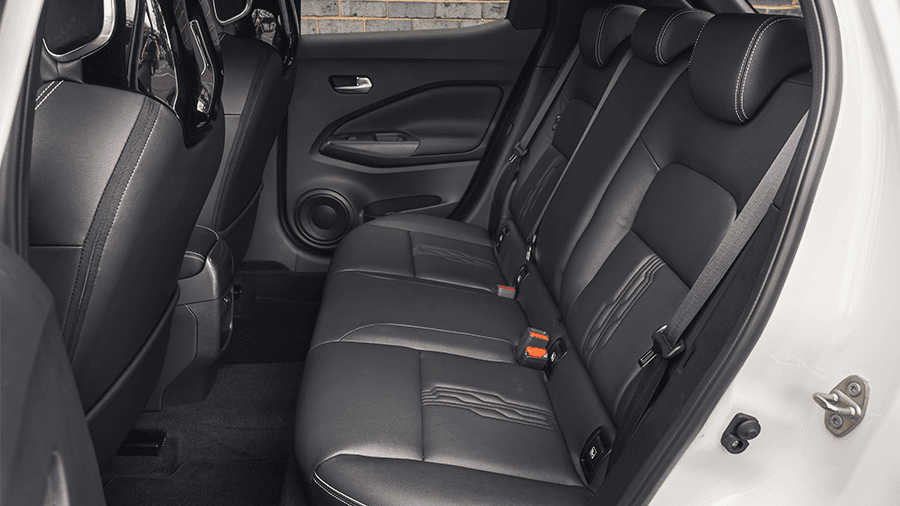
Boot space in the petrol-only Juke is 422 litres. But this is reduced to 354 litres in the hybrid, thanks to the positioning of the battery. In addition, the rear seats fold down in a 60/40 split to expand the capacity to 1,114 litres, which is 191 litres less than the fossil-fuelled version.
The boot floor is adjustable, too, which helps to minimise the boot lip when in its higher position. Plus, it creates room underneath to put the parcel shelf if you need to take it out.

Safety
Crash-testing safety body Euro NCAP put the Nissan Juke through its paces in 2019.
It was rated five stars, scoring an impressive 94 per cent for adult occupants, 85 per cent for children and 73 per cent for safety assists.
Standard safety equipment includes intelligent emergency braking with pedestrian and cyclist recognition, lane departure warning, intelligent lane intervention and high beam assist. You also get traffic sign recognition, automatic hazard and emergency stop signals, height-adjustable seat belts, a tyre pressure monitoring system, ABS brakes with brake assist, vehicle dynamic control, an electronic stability programme, and active trace control, active ride control, and hill start assist.
Tekna trim and above gets the Advanced Safety Shield Pack. This bundle includes an intelligent around-view monitor (essentially a 360-degree colour camera), intelligent driver alertness, blind spot intervention, rear cross-traffic alert, intelligent cruise control, lane keep assist and moving object detection.

Options
The new Nissan Juke Hybrid comes as standard in a fresh colour: magnetic blue, while new ceramic grey is also available.
Alternative colours cost a few hundred pounds extra, while a selection of upholstery types is available in higher trims at no additional cost. The N-Connecta trim can upgrade from 17-inch to 19-inch alloys for a fee, too.
On lower spec cars, you can add most of the features of the higher trim levels by purchasing a series of packs.
The Comfort Pack, which adds automatic climate control, rain-sensing wipers, heated front seats, and heated and auto-folding mirrors, costs a few hundred pounds.
The Advanced Safety Shield Pack, which we mentioned earlier, costs four figures, and for a little more you can get the same along with Traffic Jam Pilot, which can automatically move the car forward and to a stop again in queues.
The Heat Pack, which adds height adjustment to the passenger seat and a heated windscreen, is relatively inexpensive. You also get heated front seats, which are included with the Comfort Pack.
Of course, some of these features are already included as standard on some grades.
A spare wheel can be had for a song, while numerous styling elements can be added, including illuminated door sills, front bumper finishers in varying shades and a coloured pack for all the bumpers and sides.
There is a choice of designs for the roof, too. Numerous options are also available for tow bars and bike racks.

Rival Cars
The Toyota CH-R hybrid is a similar size and shape to the Nissan Juke, offering parallel fuel economy and emissions. It is more expensive, though, plus Toyota also provides a more powerful version.
Renault offers the Captur in mild and plug-in hybrid forms, which is worth looking at.
The Volkswagen T-Cross and the Skoda Kamiq are sister cars based on the same platform, so they share many of the same components. But neither offers a hybrid model.
Both are worth considering, though, having bigger boots than the Juke and more space for rear-seat passengers. However, neither has the quirky looks and seem bland compared with the Nissan’s livelier appearance.
Conversely, the excellent and full-of-personality Peugeot 2008 is available as an all-electric offering, (the e-2008), but there are no hybrid models.

Verdict & Next Steps
The latest Nissan Juke offers a big step forward compared with its forerunner, with better driving dynamics, improved practicality, and an overhauled interior far more advanced than before.
The hybrid offers obvious cost savings over a conventional petrol-only model. But there are better alternatives out there if the quirkiness of its aesthetics isn’t your cup of tea.
The Tekna trim is well-equipped, but the N-Connecta is almost as good, helped by the fact that it’s virtually the same spec as the petrol model, which also offers two more trims beneath it.
Safety-conscious people may want the Advanced Safety Shield pack, but this pushes the Nissan’s price to a level where better cars to lease may come into play.
Nevertheless, the Juke Hybrid is a worthy contender, offering fuel-saving capability on top of a vastly improved, decent car.
Where to next?
View our latest Nissan Juke Hybrid lease deal - from just £250.79 per month inc VAT**
Looking for a great leasing deal? Check out our incredible range of Special Offers
New Hatchback? Read our latest Car Reviews and find the right model for you
Want to know more about leasing? Take a look at our comprehensive Leasing Guides
Interested in everything motoring? Why not catch up on all the latest Car Leasing News.
*Score based on Select’s unique meta score analysis, taking into account the UK’s top five leading independent car website reviews of the Nissan Juke Hybrid
**Correct as of 13/07/2022. Based on 9 months initial payment, 5,000 miles over a 48 month lease. Initial payment equivalent to 9 monthly payments or £2,257.11Ts and Cs apply. Credit is subject to status.




















